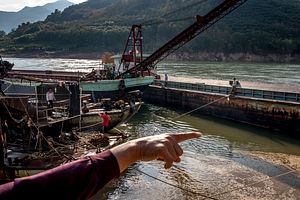Luc Forsyth and Gareth Bright have set out on a journey to follow the Mekong river from sea to source, The Diplomat will be sharing some of the stories they’ve found along the way. For more about the project, check out the whole series here.
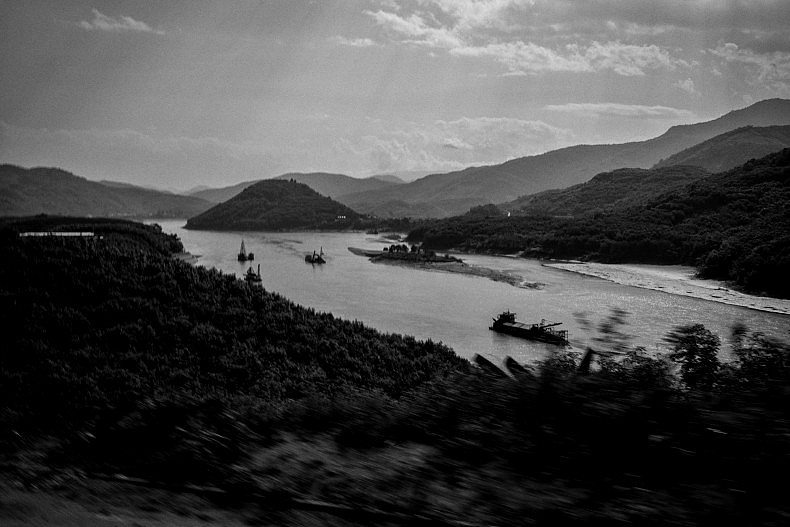
Sand dredgers work along the banks of the Lancang (Mekong) river in Simaogangzhen, Yunan, China. Photo by Gareth Bright.
When we decided to head to the small town of Simaogang, we had no idea what connection – if any – the place would have to the Lancang. We quickly learned that river sand is one of the area’s major exports, and spent several days with a crew of sand dredgers to learn how the Lancang’s sand is brought to market.
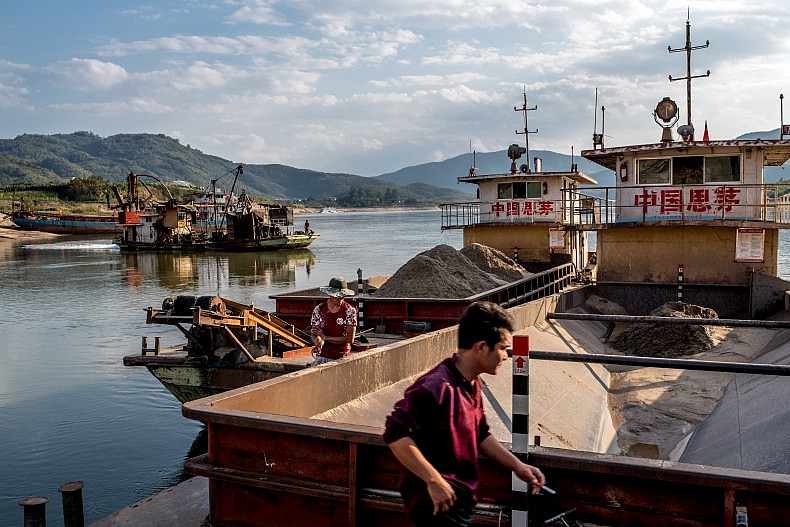
A small fleet of ships works day in and day out dredging up sand from the river. Photo by Luc Forsyth.
In the golden light of dawn the rusted bolts and gears of the ship’s aging crane screamed in protest as load after load of wet Lancang sand was lifted into the hold of the dredging barges. All along the waterfront of the small town of Simaogang dredgers of differing sizes worked the river’s banks. From atop a concrete wall high above the thrum, the company’s owner, Mr. Shen, watched his fleet begin another day.
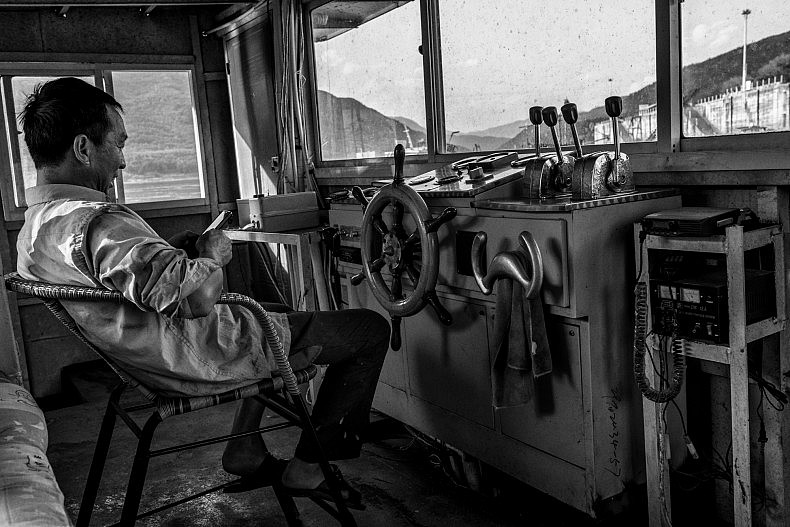
The captain of a sand dredging vessel mans the cockpit in the early morning in the town of Simaogang, Yunnan, China. Photo by Gareth Bright.
The decision to visit Simaogang, like so many we had made during the production of A River’s Tail, was made more or less at random. We had left the major city of Jinghong so we could follow the Lancang north towards the border of the Tibetan autonomous region, but among the many towns that lined the banks of the river in Yunnan province we had been at a loss for where to go. Online searches had given us little insight into which would be the most suitable places to learn about contemporary issues facing the river, and so we had settled on Simaogang simply because a decision had to be made.
After a day of travel on a series of local buses, we reached the small town and headed to the river to see if our decision had been a good one.
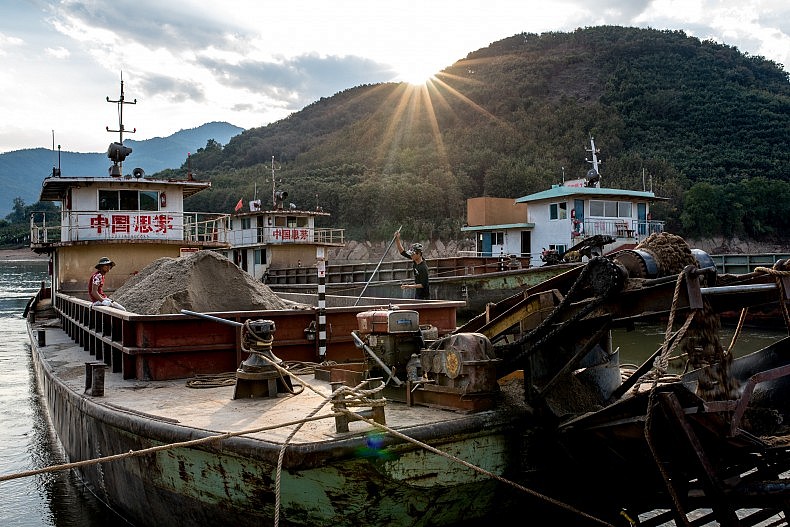
The sun peeks over the mountains at the beginning of another day dredging sand from the Lancang. Photo by Luc Forsyth.
We’d already seen the potential effects that sand dredging could have on riparian communities when we’d visited a Cambodian village that was literally sinking into the Mekong one meter at a time, so when we saw the dredgers arrayed before us in Simaogang, we knew we had found a story.
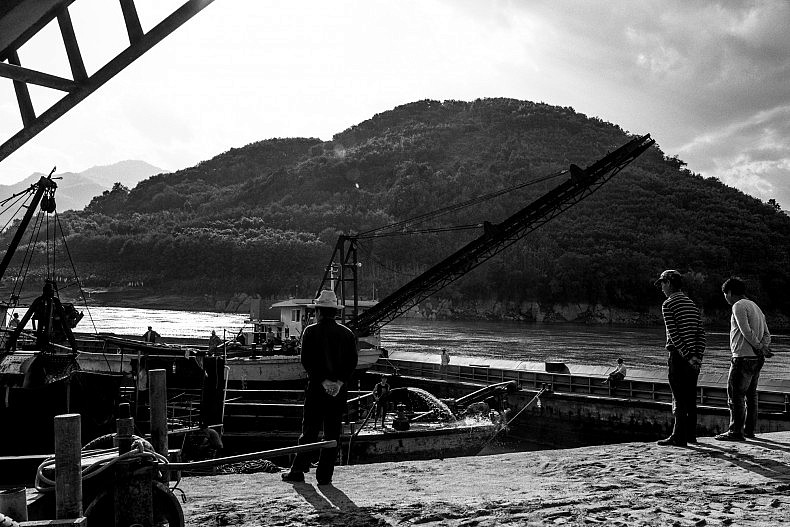
Men stand on the banks of the Lancang. Photo by Gareth Bright.
Sunup to Sundown
As the sun rose at 8 a.m. (all of China operates under the same time zone as Beijing, resulting in especially late mornings in the country’s western provinces), workers gathered at the river’s edge to sip tea and chat before taking to their boats. Many had their hoods drawn tightly around their faces to ward off the morning chill, most chain smoking and not yet fully awake.
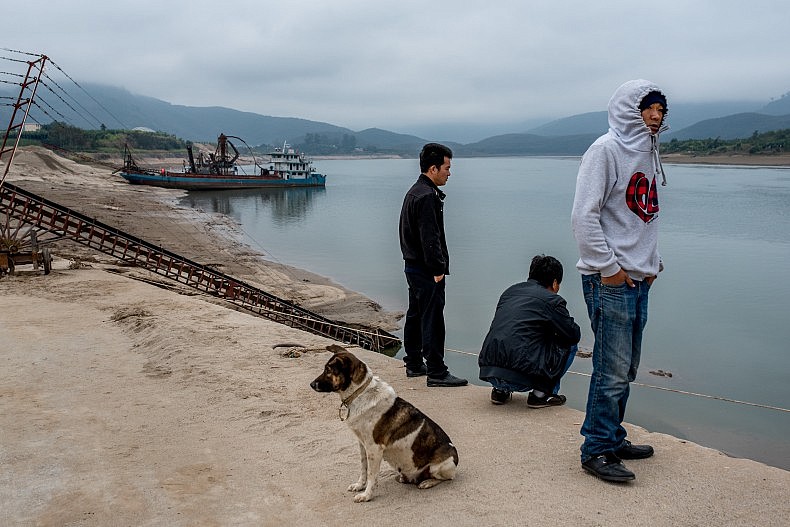
Sand dredgers try to keep warm before the day’s work begins in Simaogang. Photo by Luc Forsyth.
The process of dredging the Lancang’s sand was a relatively simple one. Whether by sucking the sand from the river bottom through snaking lengths of piping or simply lifting it up between the teeth of metal buckets, the methods employed by the crew of Mr. Shen’s boats to get sand out of the water and onto land were little more than the industrial manifestation of a playing child’s imagination.
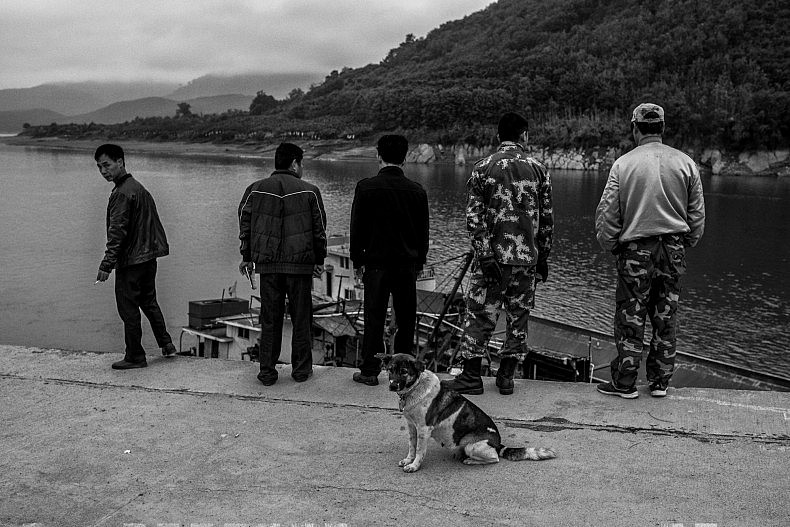
A crew from one of the Sand dredgers line the shore of the Lancang (Mekong) river. Photo by Gareth Bright.
At a signal from Mr. Shen, the day’s work began. Those standing on the river banks climbed aboard their vessels and moved below decks to start diesel engines that rumbled to life, shattering the morning quiet. The largest of the dredgers slipped their mooring lines and reversed slowly into deeper water while smaller boats stayed close to land, their cranes swinging in and out of the water with practiced speed.
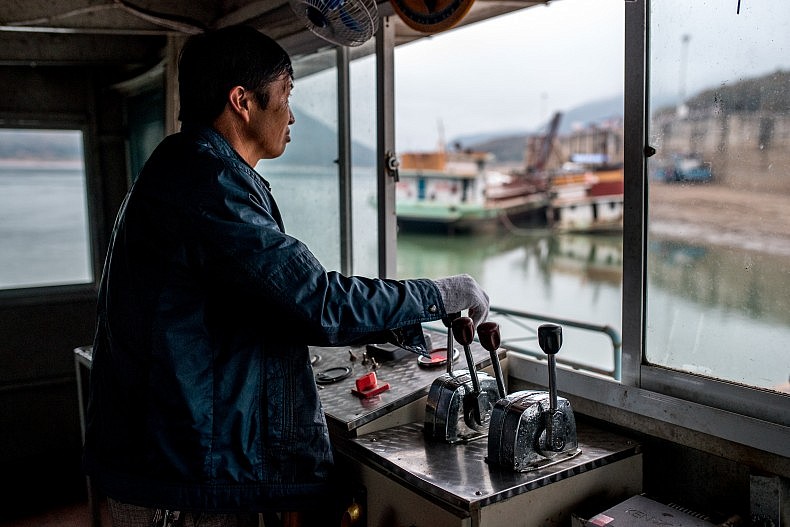
The captain of a sand dredging vessel mans the cockpit in the early morning. Photo by Luc Forsyth.
Huge conveyor belts mounted on steel dollies were shifted into position until they overlapped perfectly, creating a continuous moving pathway from ship to shore. Teams of two used long metal shovels to feed the sand accumulating in the open air holds onto the first belt in the chain. The belts were angled upwards at roughly 40 degrees, and along them the sand travelled into the air until reaching the terminus and falling 10 meters below to the next belt.
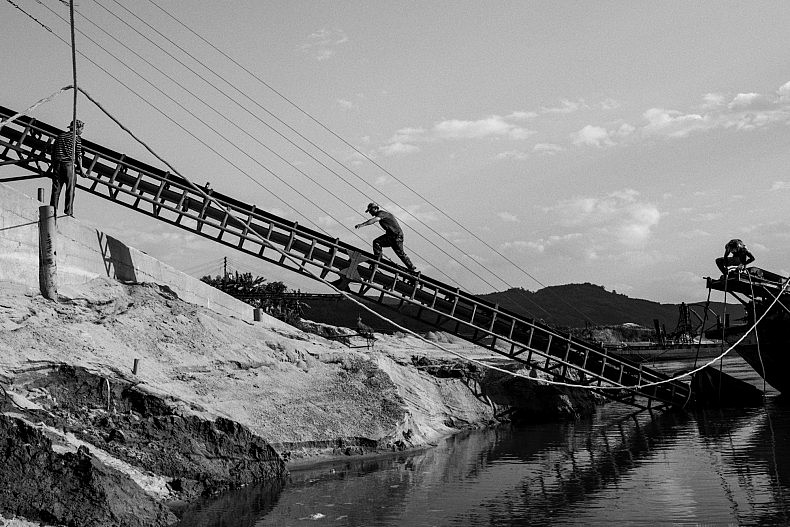
Huge conveyor belts move sand from ship to shore. Photo by Gareth Bright.
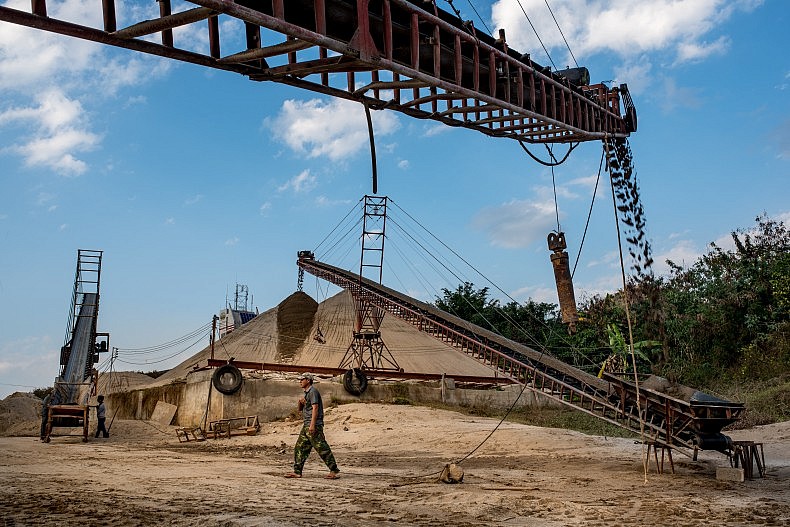
Conveyor belts move sand from the dredging boats to the shore for drying. Photo by Luc Forsyth.
At the end of the chain the sand was piled in great mounds, cascading down the sides in a series of endless avalanches. A steady stream of motley vehicles – from full sized dump trucks to small tractors with homemade buckets welded to their chassis – queued along the wharf awaiting their turn to be filled with sand by the single ceaselessly working bulldozer.
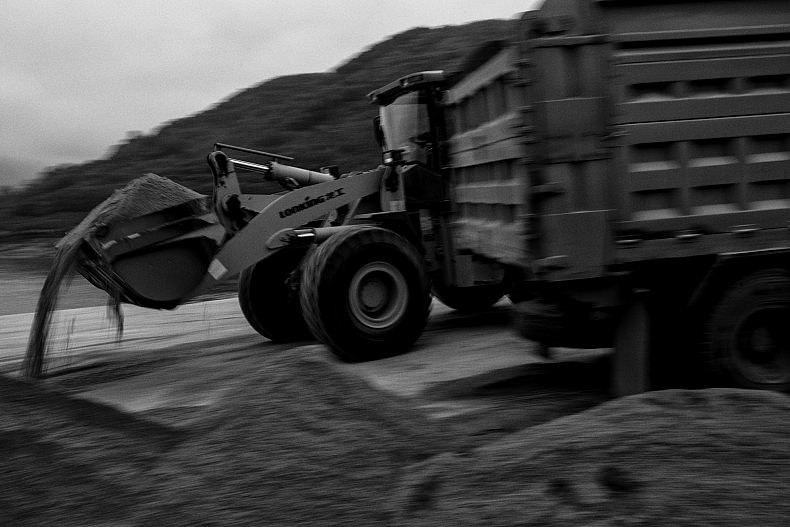
Trucks wait to be loaded with dredged sand in the town of Simaogang, Yunnan, China. Photo by Gareth Bright.
Mr. Shen paced along the waterfront throughout the day, supervising the operation and ordering adjustments to the position of the conveyor belts when necessary. Apart from a short break for noodles and tea at midday, the work continued uninterrupted until the sun set at 7 p.m.

Sand dredgers stop for lunch in the town of Simaogang, Yunnan China. Photo by Luc Forsyth.
The workers were not locals. Most were, like Mr. Shen, from Kunming – 500 km to the northeast – and so had no close friends or family in Simaogang apart from their fellow laborers. The small rooms they lived in, while fairly well built and tidy, were not exactly homey and so the men (the operation employed no women save a single cook) spent most of their free time in the communal dining area drinking tea or clustered around a shared mahjong table.
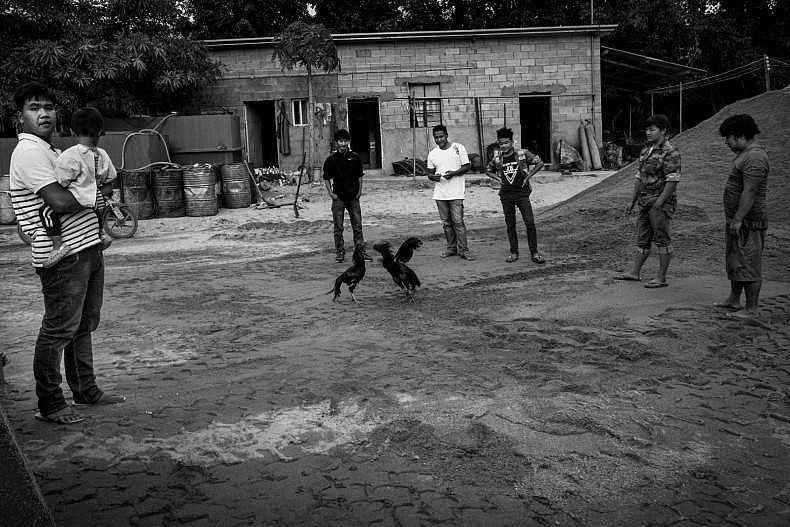
The crew of a sand dredging vessel watch a cock fight at the end of their workday. Photo by Gareth Bright.
At night most ventured into the town to play pool or drink a few beers, but the tiny town did not offer much in the way of nightlife. When we asked the men how they felt about living and working away from their families, the company’s accountant spoke for the group: “It’s a good job and it is only 6 hours back to Kunming. I used to work in Laos, and that was much further.”
We left the men to their pool and smoking, knowing that we would see them all again the next morning when the dredging began anew.
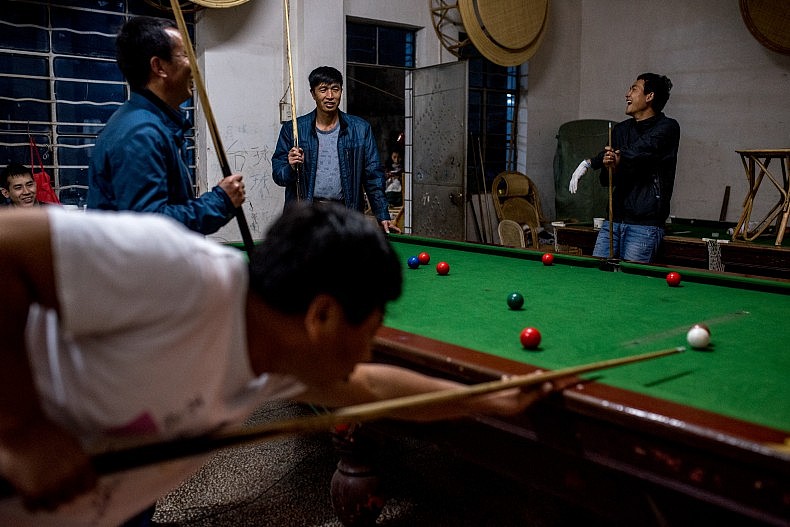
The crew of a sand dredging vessel relax by playing pool at the end of their workday. Photo by Luc Forsyth.
Outpacing Demand
Sand, one of the planet’s most unglamorous resources, is something most people pay little attention to. It is unremarkable to look at and seemingly everywhere in great quantities and so its importance is often overlooked. But without sand, there can be no concrete, and without concrete, there are no new apartment buildings for the world’s increasingly urbanized population to live in. Contrary to to how it may seem while sitting on the a beach, sand is not available in limitless supply. It is a finite resource like any other and it must be collected from somewhere before it reaches the world’s construction sites.
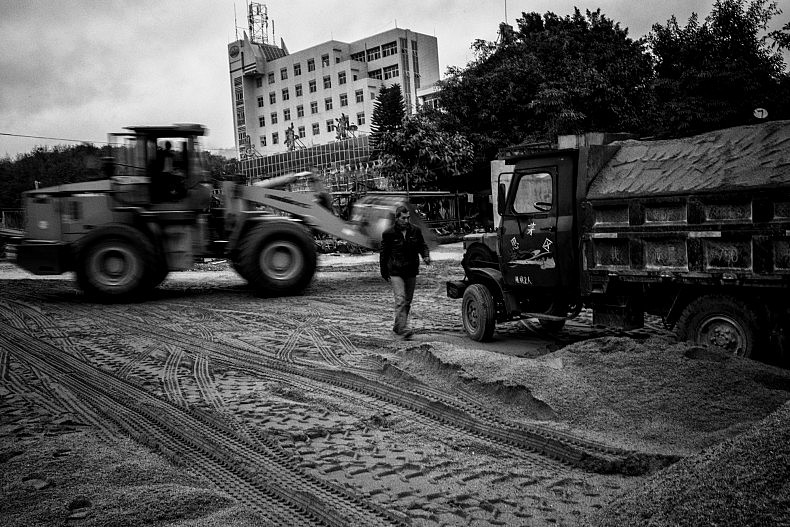
Trucks wait to be loaded with dredged sand. Photo by Gareth Bright.
“Sometimes the river moves very fast, and it is harder to collect the sand,” Mr. Shen said as he watched his ships perform the monotonous act of bringing the Lancang’s sand to the surface. The 53-year-old had worked in a wire factory in Kunming for most of his life before starting the dredging business several years ago, seeing an opportunity to supply the building material so essential in a nation that has some of the highest rates of urban construction in the world.
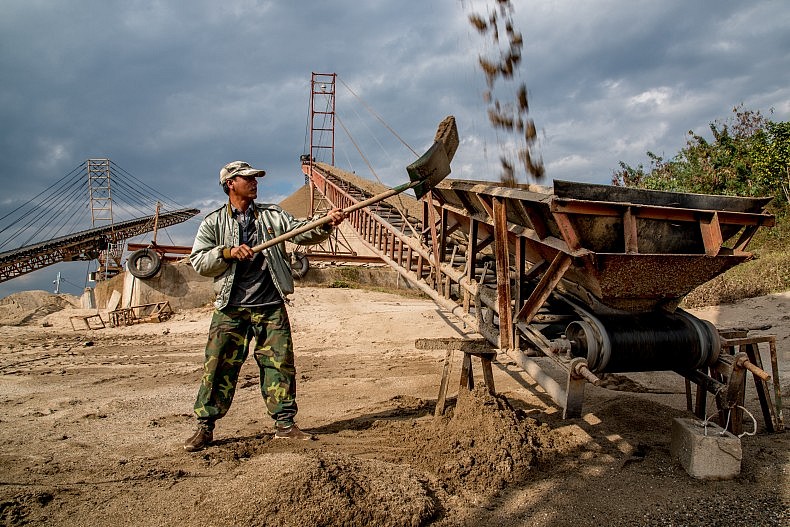
A man shovels spilled sand onto a conveyor belts which moves sand from the dredging boats to the shore for drying. Photo by Luc Forsyth.
With around a dozen vessels of varying sizes under his command, his company seemed to have grown incredibly quickly in its few years of existence. But Mr. Shen seemed reluctant to reveal how he had built such a substantial enterprise in such a short time on the savings of a factory worker, so we did not press him too heavily for this information. However he had done it, his ships were extracting more than 1500 tonnes of river sand each day, year round.
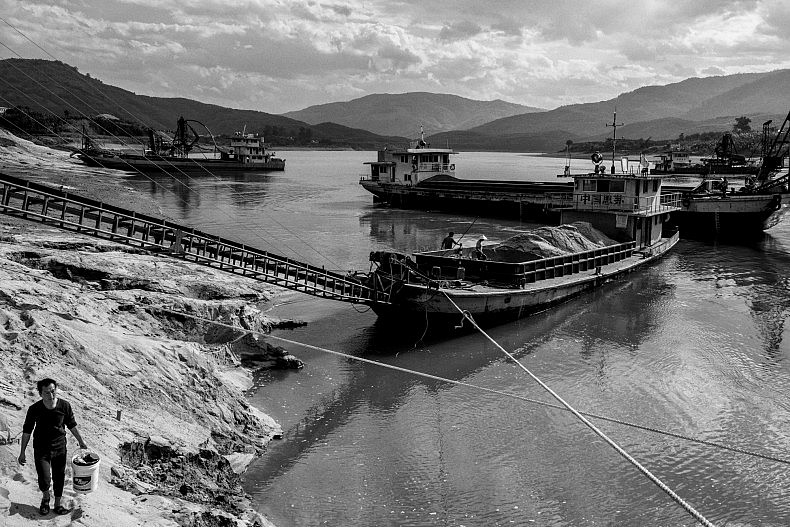
Mr. Shen says his ships extract more than 1500 tonnes of river sand each day, year round. Photo by Gareth Bright.
While some of this sand was needed for local construction purposes, most of it was transported to the regional capital, Jinghong, to fuel China’s massive housing and infrastructure building industries. However, Mr. Shen said, these sectors were slowing, and bringing his profits down with them.
“Two years ago a ton of sand used to sell for 40 Yuan (roughly $6 US), but now the price is just 24 Yuan. We used to ship it all by boat [along the Lancang] to Jinghong, but now there is no demand. I hope it will go back up after the new year.”
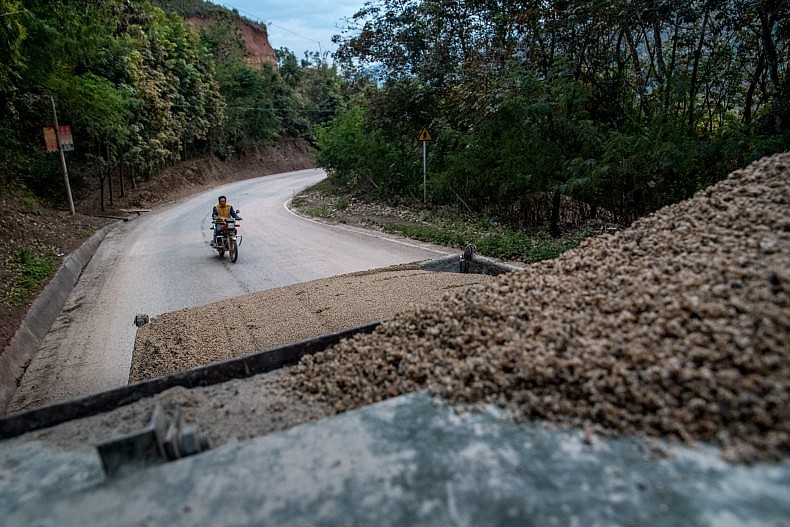
A driver hauls a load of sand to a construction site in Simaogang, Yunnan. Photo by Luc Forsyth.
With ghost towns of hundreds of thousands of empty apartments sitting on the outskirts of many major cities, it was difficult to know when China’s construction market might rebound, but for the time being, Mr. Shen and his fleet would continue to bring the Lancang’s sand to market.
This piece originally appeared at A River’s Tail.













